-

新人教版高中英语选修2Unit 2 Using langauge-Listening教学设计
? B: Absolutely! Getting involved with Chinese cultural activities there definitely helped a lot. I got to practice my Chinese on a daily basis, and I could learn how native Chinese speakers spoke.? A: What do you feel is your biggest achievement?? B: Learning Chinese characters! I have learnt about 1,500 so far. When I first started, I didn't think it was even going to be possible to learn so many, but now I find that I can read signs, menus, and even some easy newspaper articles.? A: What are you most keen on?? B: I've really become keen on learning more about the Chinese culture, in particular Chinese calligraphy. As I have learnt Chinese characters, I have developed a great appreciation for their meaning. I want to explore Chinese characters by learning how to write them in a more beautiful way. ? A: Finally, what do you want to say to anyone interested in learning Chinese?? I have really become keen on learning more about the Chinese culture, in particular Chinese Calligraphy. As I have learnt Chinese character, I have developed a great appreciation for their meaning. I want to explore Chinese characters by learning how to write them in a more beautiful way.? A: Finally, what do you want to say to anyone interested in learning Chinese?? B: I'd say, give it a shot! While some aspects may be difficult, it is quite rewarding and you will be happy that you tried.? A: Thanks for your time. ? B:You're welcome.

新人教版高中英语选修2Unit 3 Using langauge-Listening教学设计
1. How is Hunan cuisine somewhat different from Sichuan cuisine?The heat in Sichuan cuisine comes from chilies and Sichuan peppercorns. Human cuisine is often hotter and the heat comes from just chilies.2.What are the reasons why Hunan people like spicy food?Because they are a bold people. But many Chinese people think that hot food helps them overcome the effects of rainy or wet weather.3.Why do so many people love steamed fish head covered with chilies?People love it because the meat is quite tender and there are very few small bones.4.Why does Tingting recommend bridge tofu instead of dry pot duck with golden buns?Because bridge tofu has a lighter taste.5 .Why is red braised pork the most famous dish?Because Chairman Mao was from Hunan, and this was his favorite food.Step 5: Instruct students to make a short presentation to the class about your choice. Use the example and useful phrases below to help them.? In groups of three, discuss what types of restaurant you would like to take a foreign visitor to, and why. Then take turns role-playing taking your foreign guest to the restaurant you have chosen. One of you should act as the foreign guest, one as the Chinese host, and one as the waiter or waitress. You may start like this:? EXAMPLE? A: I really love spicy food, so what dish would you recommend?? B: I suggest Mapo tofu.? A: Really ? what's that?

新人教版高中英语选修2Unit 4 Learning about Language教学设计
This section guides students to pay attention to the typical context of vocabulary use, helps students accumulate vocabulary around the key vocabulary of this unit, and uses the learned words and word chunks in different contexts to deeply understand their meaning and usage, so as to achieve the purpose of review and consolidation.The teaching design activities aim to guide students to pay attention to the typical context in which the target vocabulary is used, as well as the common vocabulary used in collocation, so that students can complete the sentence with correct words. In terms of vocabulary learning strategies, this unit focuses on cultivating students' ability to pay attention to collocation of words and to use word blocks to express meaning.For vocabulary learning, it is not enough just to know the meaning of a single word, but the most important thing is to master the common collocations of words, namely word blocks.Teachers should timely guide students to summarize common vocabulary collocation, such as verb and noun collocation, verb and preposition collocation, preposition and noun collocation, and so on.1. Guide students to understand and consolidate the meaning and usage of the vocabulary in the context, 2. Guide the students to use the unit topic vocabulary in a richer context3. Let the students sort out and accumulate the accumulated vocabulary, establishes the semantic connection between the vocabulary,4. Enable students to understand and master the vocabulary more effectivelyGuiding the Ss to use unit topic words and the sentence patterns in a richer context.

新人教版高中英语选修2Unit 4 Reading for writing教学设计
假定你是英国的Jack,打算来中国旅行,请你给你的中国笔友李华写一封信,要点如下:1.你的旅行计划:北京→泰山→杭州;2.征求建议并询问他是否愿意充当你的导游。注意:1.词数80左右(开头和结尾已给出,不计入总词数);2.可以适当增加细节,以使行文连贯。参考词汇:故宫 the Forbidden City;泰山 Mount TaiDear Li Hua,I'm glad to tell you that 'm going to visit China.First,I am planning to visit Beijing,the capitalof China,where I am looking forward to enjoying the Great Wall,the Forbidden City and somebeautiful parks.Then I intend to go to visit Mount Tai in Shandong Province.I've heard that it is one ofthe most famous mountains in China and I can't wait to enjoy the amazing sunrise there.After that,I amalso going to Hangzhou.It is said that it is a beautiful modern city with breathtaking natural sights,among which the West Lake is a well- known tourist attraction.What do you think of my travel plan? Will you act as my guide? Hope to hear from you soon.

新人教版高中英语选修2Unit 5 Learning about Language教学设计
The purpose of this section of vocabulary exercises is to consolidate the key words in the first part of the reading text, let the students write the words according to the English definition, and focus on the detection of the meaning and spelling of the new words. The teaching design includes use English definition to explain words, which is conducive to improving students' interest in vocabulary learning, cultivating their sense of English language and thinking in English, and making students willing to use this method to better grasp the meaning of words, expand their vocabulary, and improve their ability of vocabulary application. Besides, the design offers more context including sentences and short passage for students to practice words flexibly.1. Guide students to understand and consolidate the meaning and usage of the vocabulary in the context, 2. Guide the students to use the unit topic vocabulary in a richer context3. Let the students sort out and accumulate the accumulated vocabulary, establishes the semantic connection between the vocabulary,4. Enable students to understand and master the vocabulary more effectivelyGuiding the Ss to use unit topic words and the sentence patterns in a richer context.Step1: Read the passage about chemical burns and fill in the blanks with the correct forms of the words in the box.

新人教版高中英语选修2Unit 5 Using langauge-Listening教学设计
The theme of this section is to learn how to make emergency calls. Students should learn how to make emergency calls not only in China, but also in foreign countries in English, so that they can be prepared for future situations outside the home.The emergency telephone number is a vital hotline, which should be the most clear, rapid and effective communication with the acute operator.This section helps students to understand the emergency calls in some countries and the precautions for making emergency calls. Through the study of this section, students can accumulate common expressions and sentence patterns in this context. 1.Help students accumulate emergency telephone numbers in different countries and learn more about first aid2.Guide the students to understand the contents and instructions of the telephone, grasp the characteristics of the emergency telephone and the requirements of the emergency telephone.3.Guide students to understand the first aid instructions of the operators.4.Enable Ss to make simulated emergency calls with their partners in the language they have learned1. Instruct students to grasp the key information and important details of the dialogue.2. Instruct students to conduct a similar talk on the relevant topic.Step1:Look and discuss:Match the pictures below to the medical emergencies, and then discuss the questions in groups.

新人教版高中英语选修2Unit 3 Reading for writing教学设计
The theme of this part is to write an article about healthy diet. Through reading and writing activities, students can accumulate knowledge about healthy diet, deepen their understanding of the theme of healthy diet, and reflect on their own eating habits. This text describes the basic principles of healthy diet. The author uses data analysis, definition, comparison, examples and other methods. It also provides a demonstration of the use of conjunctions, which provides important information reference for students to complete the next collaborative task, writing skills, vivid language materials and expressions.1. Teach Ss to learn and skillfully use the new words learned from the text.2. Develop students’ ability to understand, extract and summarize information.3. Guide students to understand the theme of healthy diet and reflect on their own eating habits.4. To guide students to analyze and understand the reading discourse from the aspects of theme content, writing structure, language expression, etc., 5. Enable Ss to write in combination with relevant topics and opinions, and to talk about their eating habits.1. Guide students to analyze and understand the reading discourse from the aspects of theme content, writing structure, language expression, etc.2. Enable them to write in combination with relevant topics and opinions, and to talk about their eating habits.3. Guide the students to use the cohesive words correctly, strengthen the textual cohesion, and make the expression fluent and the thinking clear.Step1: Warming upbrainstorm some healthy eating habits.1.Eat slowly.2.Don’t eat too much fat or sugar.3.Eat healthy food.4.Have a balanced diet.Step2: Read the passage and then sum up the main idea of each paragraph.

新人教版高中英语选修2Unit 4 Using langauge-Listening教学设计
The theme of the listening section is " talking about scenery and culture along a journey."The part is designed to further lead the students to understand Canadian natural geography and social environment, and integrated into the cultural contrast by mentioning the long train journey from Beijing to Moscow routes. On this basis, the part activates students related travel experience, lets the student serial dialogue, guides the student to explore further the pleasure and meaning of the long journey, and Chinese and foreign cultural comparison.The part also provides a framework for the continuation of the dialogue, which is designed to provide a framework for students to successfully complete their oral expressions, and to incorporate an important trading strategy to end the dialogue naturally.1. Help students to understand and master some common English idioms in the context, and experience the expression effect of English idioms.2. Guide the students to understand the identity of different people in the listening context, and finish the dialogue according to their own experience.3. Instruct the students to use appropriate language to express surprise and curiosity about space and place in the dialogue, and master the oral strategy of ending the dialogue naturally.1. Instruct students to grasp the key information and important details of the dialogue.2. Instruct students to conduct a similar talk on the relevant topic.

新人教版高中英语选修2Unit 5 Reading and thinking教学设计
The theme of this activity is to learn the first aid knowledge of burns. Burns is common in life, but there are some misunderstandings in manual treatment. This activity provides students with correct first aid methods, so as not to take them for granted in an emergency. This section guides students to analyze the causes of scald and help students avoid such things. From the perspective of text structure and collaborative features, the text is expository. Expository, with explanation as the main way of expression, transmits knowledge and information to readers by analyzing concepts and elaborating examples. This text arranges the information in logical order, clearly presents three parts of the content through the subtitle, accurately describes the causes, types, characteristics and first aid measures of burns, and some paragraphs use topic sentences to summarize the main idea, and the level is very clear.1. Guide students to understand the causes, types, characteristics and first aid methods of burns, through reading2. Enhance students’ ability to deal withburnss and their awareness of burns prevention3. Enable students to improve the ability to judge the types of texts accurately and to master the characteristics and writing techniques of expository texts.Guide students to understand the causes, types, characteristics and first aid methods of burns, through readingStep1: Lead in by discussing the related topic:1. What first-aid techniques do you know of ?CPR; mouth to mouth artificial respiration; the Heimlich Manoeuvre
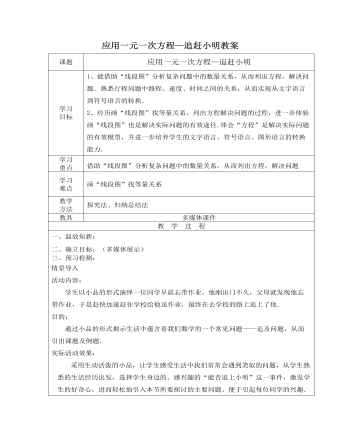
北师大初中七年级数学上册应用一元一次方程——追赶小明教案2
由于题目较简单,所以学生分析解答时很有信心,且正确率也比较高,同时也进一步体会到了借助“线段图”分析行程问题的优越性.六、归纳总结:活动内容:学生归纳总结本节课所学知识:1.会借线段图分析行程问题.2.各种行程问题中的规律及等量关系.同向追及问题:①同时不同地——甲路程+路程差=乙路程; 甲时间=乙时间.②同地不同时——甲时间+时间差=乙时间; 甲路程=乙路程.相向的相遇问题:甲路程+乙路程=总路程; 甲时间=乙时间.目的:强调本课的重点内容是要学会借线段图来分析行程问题,并能掌握各种行程问题中的规律及等量关系.引导学生自己对所学知识和思想方法进行归纳和总结,从而形成自己对数学知识的理解和解决问题的方法策略.
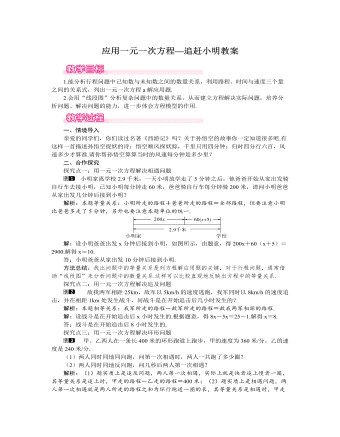
北师大初中七年级数学上册应用一元一次方程——追赶小明教案1
解:(1)设x分钟后两人第一次相遇,由题意,得360x-240x=400.解得x=103.(103×360+103×240)÷400=5(圈).答:两人一共跑了5圈.(2)设x分钟后两人第一次相遇,由题意,得360x+240x=400.解得x=23(分钟)=40(秒).答:40秒后两人第一次相遇.方法总结:环形问题中的相等关系:两个人同地背向而行:相遇问题(首次相遇),甲的行程+乙的行程=一圈周长;两个人同地同向而行:追及问题(首次追上),甲的行程-乙的行程=一圈周长.三、板书设计追赶小明→行程问题→相遇问题追及问题环形问题教学过程中,通过对开放性问题的探讨与交流,体验生活中数学的应用与价值,感受数学与人类生活的密切联系,激发学生学习数学的兴趣,培养学生的创新意识、团队精神和克服困难的勇气.
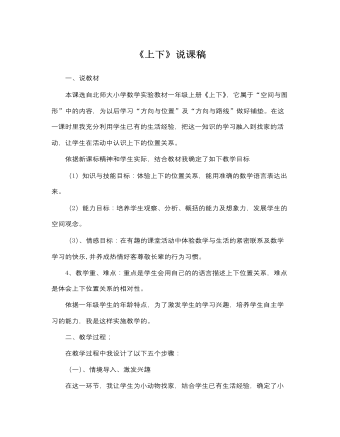
北师大版小学数学一年级上册《上下》说课稿
一、说教材本课选自北师大小学数学实验教材一年级上册《上下》,它属于“空间与图形”中的内容,为以后学习“方向与位置”及“方向与路线”做好铺垫。在这一课时里我充分利用学生已有的生活经验,把这一知识的学习融入到找家的活动,让学生在活动中认识上下的位置关系。依据新课标精神和学生实际,结合教材我确定了如下教学目标(1)知识与技能目标:体验上下的位置关系,能用准确的数学语言表达出来。(2)能力目标:培养学生观察、分析、概括的能力及想象力,发展学生的空间观念。(3)、情感目标:在有趣的课堂活动中体验数学与生活的紧密联系及数学学习的快乐,并养成热情好客尊敬长辈的行为习惯。4、教学重、难点:重点是学生会用自己的的语言描述上下位置关系,难点是体会上下位置关系的相对性。依据一年级学生的年龄特点,为了激发学生的学习兴趣,培养学生自主学习的能力,我是这样实施教学的。
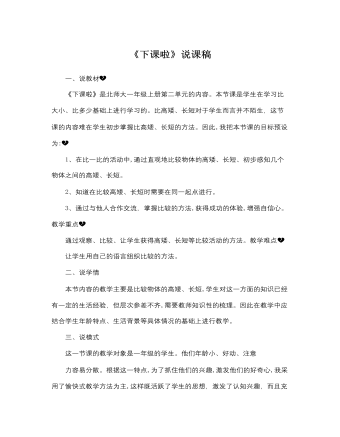
北师大版小学数学一年级上册《下课啦》说课稿
一、说教材《下课啦》是北师大一年级上册第二单元的内容。本节课是学生在学习比大小、比多少基础上进行学习的。比高矮、长短对于学生而言并不陌生,这节课的内容难在学生初步掌握比高矮、长短的方法。因此,我把本节课的目标预设为:1、在比一比的活动中,通过直观地比较物体的高矮、长短、初步感知几个物体之间的高矮、长短。2、知道在比较高矮、长短时需要在同一起点进行。3、通过与他人合作交流,掌握比较的方法,获得成功的体验,增强自信心。教学重点通过观察、比较、让学生获得高矮、长短等比较活动的方法。教学难点让学生用自己的语言组织比较的方法。二、说学情本节内容的教学主要是比较物体的高矮、长短,学生对这一方面的知识已经有一定的生活经验,但层次参差不齐,需要教师知识性的梳理。因此在教学中应结合学生年龄特点、生活背景等具体情况的基础上进行教学。
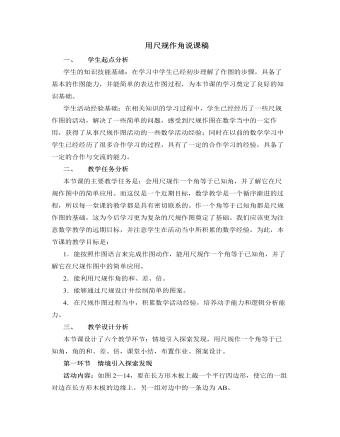
北师大版初中七年级数学下册用尺规作角说课稿
活动目的:通过两个图案设计,一个是让学生独立思考,借助于已经学习的用尺规作线段和角来完成,对本节课的知识进一步巩固应用;另一个是让学生根据作图步骤借助于尺规完成图案,进一步培养学生几何语言表达能力,并积累尺规作图的活动经验。活动注意事项:根据课堂时间安排,可灵活进行处理,既可以作为本节课的实际应用,也可以作为课下的联系拓广,从而使得不同层次的学生都学到有价值的数学。四、 教学设计反思1.利用现实情景引入新课,既能体现数学知识与客观世界的良好结合,又能唤起学生的求知欲望和探求意识。而在了解基础知识以后,将其进行一定的升华,也能使学生明白学以致用的道理、体会知识的渐进发展过程,增强思维能力的培养。同时,在整个探究过程中,怎样团结协作、如何共同寻找解题的突破口,也是学生逐步提高的一个途径。

人音版小学音乐一年级上法国号口风琴教学说课稿
6、学生展示此环节教学时我借助演唱和口风琴伴奏、口风琴与舞蹈律动、口风琴与打击乐合奏等形式,给时间学生自由组合,让同学们分组合作展示。力求同学之间互帮互助、相互启发,以此增进学生的团队合作精神。7、课堂小结小结时我鼓励学生开展互评、自评等方式,从而让学生正视自己,尊重他人。七、课后反思“兴趣是最好的老师”,此节音乐课的设计我觉得充满了乐趣,教学时处处呈现师生合作,生生合作的愉快场景。“大风与小风”的游戏成了本节课的亮点,它让学生在自主参与音乐实践中体会到音乐的无限魅力。但不足的是实际操作过程中由于时间的关系曲子弹得不够扎实,个别学生弹得不够熟练。以上设计如有不足之处,敬请各位专家、同仁提出宝贵意见。谢谢!
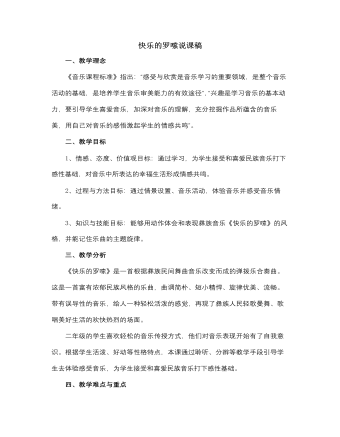
人音版小学音乐二年级上册快乐的罗嗦说课稿
一、教学理念《音乐课程标准》指出:“感受与欣赏是音乐学习的重要领域,是整个音乐活动的基础,是培养学生音乐审美能力的有效途径”,“兴趣是学习音乐的基本动力,要引导学生喜爱音乐,加深对音乐的理解,充分挖掘作品所蕴含的音乐美,用自己对音乐的感悟激起学生的情感共鸣”。二、教学目标1、情感、态度、价值观目标:通过学习,为学生接受和喜爱民族音乐打下感性基础,对音乐中所表达的幸福生活形成情感共鸣。2、过程与方法目标:通过情景设置、音乐活动,体验音乐并感受音乐情绪。3、知识与技能目标:能够用动作体会和表现彝族音乐《快乐的罗嗦》的风格,并能记住乐曲的主题旋律。三、教学分析《快乐的罗嗦》是一首根据彝族民间舞曲音乐改变而成的弹拨乐合奏曲。这是一首富有浓郁民族风格的乐曲,曲调简朴、短小精悍、旋律优美、流畅。
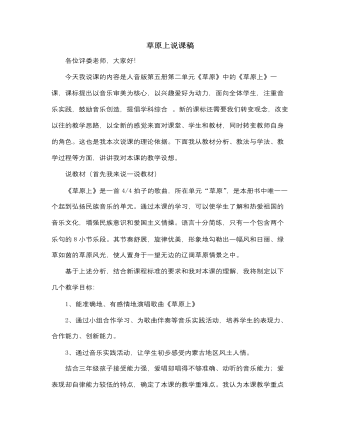
人音版小学音乐三年级上册草原上说课稿
(五)课后延伸,资源共享(进入本课的最后一个环节)让学生欣赏著名的蒙古族器乐曲《赛马》、《牧歌》;欣赏耳熟能详的蒙古族歌曲《吉祥三宝》、《美丽的草原我的家》等。【因为一个、两个的音乐作品并不能让孩子们完全的认识、领悟蒙古族音乐的丰富魅力及内涵。我利用课堂上的有效时间,趁热打铁,让他们从多角度体验音乐音响形式中的美,陶冶情操,启迪智慧。这样富有弹性的设计,有利于培养学生的创新思维,使音乐教学充满生机与活力。】总之,这节课的设计是融合律动、歌曲、表演、创编为一体的较为全面的综合课。以学生发展为前提,以“主体、创新”为主题,以“草原”为主线贯穿整堂课,充分利用多媒体教学,通过走进大草原、感受大草原、歌唱大草原、体验创新,激发热情、课后延伸,资源共享几个环节的教学,圆满地完成了本课的教学任务,落实了教学目标。

人音版小学音乐二年级上册森林水车说课稿
第四环节:森林印象1.完整聆听,找出表现小水花的主题音乐,了解回旋曲式请孩子们听到小水花的主题音乐时,轻轻地唱并用律动表现欢快的小水花——在这我给大家准备了音乐片段由水车上飞溅下来的小水花穿过了小木屋,流进了田野就这样快乐地回旋在森林中……2.介绍作曲家:这么美的音乐是德国喜歌剧作曲家艾伦贝格留给我们的,你想对他说些什么?3.在森林水车的音乐声中朗诵儿童诗来结束本课(希望孩子们就是那快乐的水花)绿色的水车转呀,快乐的小水花呀:飞着、跳着、唱着、笑着一路奔跑,一路播撒,回旋在小溪、田野、山花中一路欢呼,一路舞蹈,是你,是我,是他我们就是一群快乐的小水花!我的说课内容到这就结束了,希望今天我带来的小水花也能回旋在你们的心中
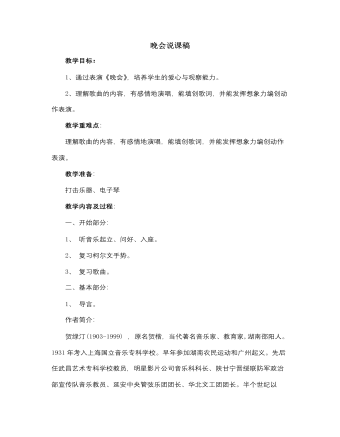
人音版小学音乐二年级上册晚会说课稿
原名《闹新年》,是贺绿汀在1934年创作的一首钢琴曲,1940年改编为管弦乐曲,并通过电台对苏联播出,深获好评。1943年作者在延安对乐曲作了修改。1949年作者把自己的六首作品编成一部管弦乐组曲,《晚会》为其中一首。乐曲如标题所示,描绘了人们欢天喜地举行晚会庆祝胜利的情景。全曲共分为六段,后三段是前三段的反复。在第三段中,作者巧妙地运用了中国民间锣鼓的节奏,使欢乐的情绪达到高潮。2、 表演《晚会》(1) 完整地聆听歌曲,用手指随着课本上的旋律滑动。(2) 听着歌曲录音跟唱全曲。(3) 分组进行编创活动。提示:利用小组的智慧你一句,我一句为歌曲编创新歌词,分组表演自己的歌。(4) 边唱边表演动作。第一段唱原词,第二段唱小组填创的歌词。(5) 背唱自创的歌曲表演《过新年》给爸爸、妈妈听。(6) 聆听《晚会》初听音乐,感受音乐的欢乐氛围。提示;音乐让你想到了什么?心情是怎样的?
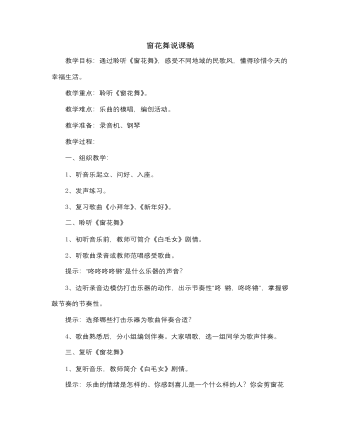
人音版小学音乐二年级上册窗花舞说课稿
3、我们知道舞蹈是舞剧的一个重要表现形式,接下来我们通过下面这段视频来想想,舞剧还有哪些表现形式呢?(播放《快乐的女战士》,老师用不同的方式来播放。)舞剧音乐有什么作用?【用有声和无声两种方式播放《快乐的女战士》,学生对比说出舞剧音乐作用,渲染、烘托舞台气氛】4、同学们现在我们知道了舞剧是一种以舞蹈为主要表现手段,综合音乐、美术、文学等艺术形式,表现特定的人物和一定戏剧情节的舞台表演艺术。艺术表现形式还有歌剧、话剧【学生能说出是以舞蹈为主,教师总结舞剧的概念】六、课堂小结:今天,我们欣赏了芭蕾舞剧《窗花舞》,也了解了什么是舞剧、舞剧所包括的艺术形式。我们只欣赏了几部经典歌剧的片段,国内外还有许多非常著名的芭蕾舞剧,希望同学们回家在网上搜集一下欣赏完整的经典芭蕾舞剧!感受这一世界奇葩的魅力!

